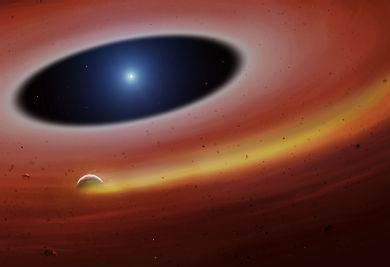In five billion years our sun will run out of fuel, expand into a red giant and finally collapse into a small, faint object called a white dwarfs.
What will happen to us and the other planets in our solar system when the sun dies?
Scientists at Warwick University have found a fragment of a planet that has survived the death of its star has been discovered in a disc of debris formed from destroyed planets, which the star ultimately consumes.
The iron and nickel rich planetesimal survived a system-wide cataclysm that followed the death of its host star, SDSS J122859.93+104032.9.
Believed to have once been part of a larger planet, its survival is all the more astonishing as it orbits closer to its star than previously thought possible, going around it once every two hours.
The discovery, reported in the journal Science, is the first time that scientists have used spectroscopy to discover a solid body in orbit around a white dwarf, using subtle variations in the emitted light to identify additional gas that the planetesimal is generating.
Using the Gran Telescopio Canarias in La Palma, the scientists studied a debris disc orbiting a white dwarf 410 light years away, formed by the disruption of rocky bodies composed of elements such as iron, magnesium, silicon, and oxygen – the four key building blocks of the Earth and most rocky bodies. Within that disc they discovered a ring of gas streaming from a solid body, like a comet’s tail. This gas could either be generated by the body itself or by evaporating dust as it collides with small debris within the disc.
The astronomers estimate that this body has to be at least a kilometre in size, but could be as large as a few hundred kilometres in diameter, comparable to the largest asteroids known in our Solar System.
White dwarfs are the remains of stars like our sun that have burnt all their fuel and shed their outer layers, leaving behind a dense core which slowly cools over time. This particular star has shrunk so dramatically that the planetesimal orbits within its sun’s original radius. Evidence suggests that it was once part of a larger body further out in its solar system and is likely to have been a planet torn apart as the star began its cooling process.
Lead author Dr Christopher Manser, a Research Fellow in the Department of Physics, said: “The star would have originally been about two solar masses, but now the white dwarf is only 70% of the mass of our Sun. It is also very small – roughly the size of the Earth – and this makes the star, and in general all white dwarfs, extremely dense.
“The white dwarf’s gravity is so strong – about 100,000 times that of the Earth’s – that a typical asteroid will be ripped apart by gravitational forces if it passes too close to the white dwarf.”







